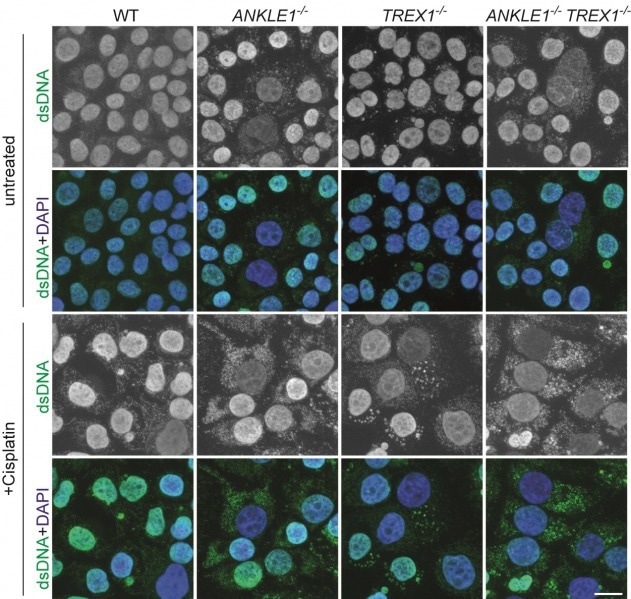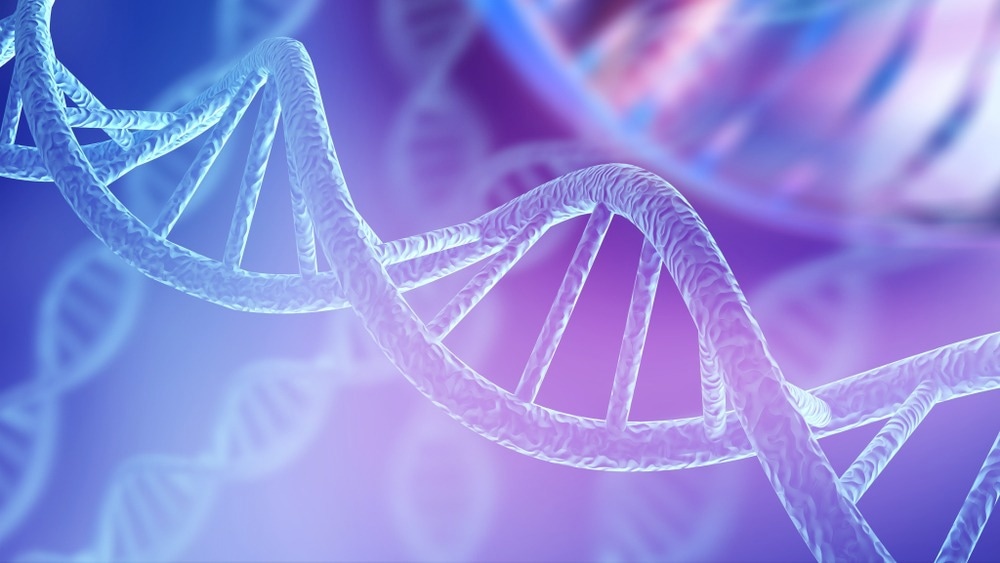Reviewed by Danielle Ellis, B.Sc.Apr 19 2023
The University of Hong Kong (HKU) School of Biological Sciences research team led by Dr. Gary Ying Wai Chan has uncovered the function of a unique enzyme called ANKLE1.

Knockout of ANKLE1 induces excessive accumulation of cytosolic DNA, leading to activation of immune responses. Image Credit: Dr Gary Ying Wai CHAN and Dr Huadong JIANG
In the midzone of dividing cells, ANKLE1 affects chromatin bridges that are trapped. ANKLE1 keeps genetic material from being harmed and prevents the immune system from unintentionally targeting the body’s own cells by severing these bridges.
To create innovative approaches to prevent or treat diseases like cancer and autoinflammatory disorders, it is crucial to comprehend the process by which chromatin bridges are split during cell division. The study, which was just published in Advanced Science, is extremely pertinent to both cancer and autoinflammation.
Background
The DNA has to be appropriately split into two new cells during cell division. However, mistakes can happen during this process, resulting in DNA fragments adhering to one another and forming chromatin bridges.
These bridges, which join two segregating masses of chromosomes in the new cell, resemble threads of DNA. They would thus unavoidably get tangled in the middle of the cell division procedure.
The actin-myosin complex, which mediates contractile forces, will break chromatin bridges that are trapped in the midzone, which can result in DNA damage and the formation of tiny nuclei known as “micronuclei,” leading to genome instability, a feature of many solid tumors, and activating innate immune responses that support autoinflammation.
The research team has recently found that ANKLE1, a special endonuclease (enzyme), plays a crucial role in cleaving chromatin bridges at the midbody during cell division, preventing catastrophic breakage caused by mechanical forces.
This discovery has enabled the i

Image Credit: Billion Photos/Shutterstock.com
nvestigation of the alternative mechanism that cells use to resolve chromatin bridges. To preserve normal DNA segregation and stability, which is crucial for avoiding diseases like cancer and autoinflammatory disorders, this alternate method helps.
The Role of ANKLE1 in Preventing DNA Damage and Autoimmunity
Caenorhabditis elegans, a small roundworm frequently used as a model organism in biological studies, has an endonuclease known as LEM-3, which was previously discovered.
In the ‘midbody,’ a structure that joins the two daughter cells during cell division, chromatin bridges have been discovered to be resolved in part by LEM-3. Abscission, the process by which the midbody is finally severed, causes the two cells to completely separate.
The study team used CRISPR/Cas9 genome editing technology to remove the ANKLE1 gene in human cells to better understand the cellular functions of ANKLE1, which is the human counterpart of LEM-3.
The research discovers that the deletion of ANKLE1 causes an increase in the creation of extended chromatin bridges, indicating that ANKLE1’s cleavage of the bridges stops the DNA from being stretched any further.
The actomyosin contractile forces that divide the two daughter cells would eventually destroy the persistent bridges in the absence of ANKLE1. Due to the large DNA fragmentation caused by the mechanical breakage, micronuclei are formed, and DNA is released into the cytosol, where it can cause inflammation and immune responses.
ANKLE1 deletion is significant because it not only causes DNA damage and genomic instability, but it also strongly activates cGAS-STING innate immunity. By detecting the DNA that is present in the cytosol, the cGAS-STING pathway provides a significant innate immune defense mechanism against infections.
Without ANKLE1, DNA fragments are easily produced when a bridge is broken, and the cytosolic DNA that results is misinterpreted for pathogenic DNA. These findings suggest that ANKLE1 is involved in both preserving genomic integrity and averting autoimmune disease.
Research Significance
The research advances the current understanding of the relationship between chromatin bridges and innate immune responses in addition to making a significant finding regarding a mechanism that uses a midbody-tethered endonuclease (ANKLE1) as a “scissor” to sever chromatin bridges to avoid genomic instability.
More and more research data suggest that immune responses play important roles in determining the clinical outcomes of many of the traditional anti-cancer drugs. For example, the use of antimitotic drugs is a common strategy to treat solid tumors. However, whether the induction of immune responses due to the resulting chromatin bridges is partly responsible for the antitumor effect remains unclear. The link between chromosomal instability and innate immunity will definitely be an area of cancer research with tremendous promise for breakthroughs.”
Dr Gary Ying Wai Chan, Assistant Professor, School of Biological Sciences, The University of Hong Kong
Source:
Journal reference:
Jiang, H., et al. (2023). Human Endonuclease ANKLE1 Localizes at the Midbody and Processes Chromatin Bridges to Prevent DNA Damage and cGAS-STING Activation. Advanced Science. doi.org/10.1002/advs.202204388